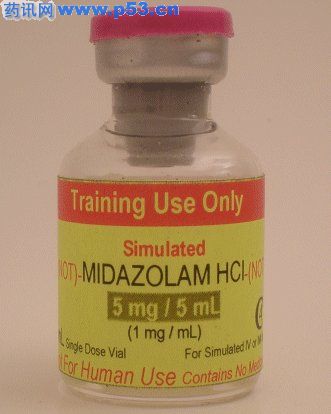|
【药品名称】 分子式: 马来酸盐C18H13ClFN3· C4H4O4 分子量: 441.8 【性状】无色至淡黄色的澄明液体。 【原产地英文商品名】MIDAZOLAM HCL 2mg/2ml/vial 10vial/box Chemistry - An imidazobenzodiazepine, midazolam occurs as a white to light yellow crystalline powder with a pKa of 6.15. Midazolam HCl’s aqueous solubility is pH dependent. At 25°C and a pH of 3.4, 10.3 mg are soluble in 1 ml of water. The pH of the commercially prepared injection is approximately 3. Storage/Stability/Compatibility - It is recommended to store midazolam injection at room temperature (15°-30°C) and protect from light. After being frozen for 3 days and allowed to thaw at room temperature, the injectable product was physically stable. Midazolam is stable at a pH from 3-3.6. Midazolam is reportedly compatible when mixed with the following products: D5W, normal saline, lactated Ringer’s, atropine sulfate, fentanyl citrate, glycopyrrolate, hydroxyzine HCl, ketamine HCl, meperidine HCl, morphine sulfate, nalbuphine HCl, promethazine HCl, sufantanil citrate, and scopolamine Hbr. Compatibility is dependent upon factors such as pH, concentration, temperature, and diluents used and it is suggested to consult specialized references for more specific information. Pharmacology - Midazolam exhibits similar pharmacologic actions as other benzodiazepines (refer to the diazepam monograph for more information). Its unique solubility characteristics (water soluble injection but lipid soluble at body pH) give it a very rapid onset of action after injection. Uses/Indications - In humans, midazolam has been suggested to be used as a premedicant before surgery, and when combined with potent analgesic/anesthetic drugs (e.g., ketamine or fentanyl), as a conscious sedative. In humans, midazolam reduces the incidences of “dreamlike” emergence reactions and increases in blood pressure and cardiac rate that ketamine causes. When compared to the thiobarbiturate induction agents (e.g., thiamylal, thiopental), midazolam has less cardiopulmonary depressant effects, is water soluble, can be mixed with several other agents, and does not tend to accumulate in the body after repeated doses. There is much interest in using the drug alone as an induction agent. Several veterinary anesthesiologists are studying the clinical applications of this agent in veterinary medicine and additional information regarding its use should be forthcoming. Pharmacokinetics - Following IM injection, midazolam is rapidly and nearly completely (91%) absorbed. Although no oral products are being marketed, midazolam is well absorbed after oral administration, but because of a rapid first-pass effect, bioavailibilities suffer (31-72%). The onset of action following IV administration is very rapid due to the high lipophilicity of the agent. In humans, the loss of the lash reflex or counting occurs within 30-97 seconds of administration. The drug is highly protein bound (94-97%) and rapidly crosses the blood-brain barrier. Because only unbound drug will cross into the CNS, changes in plasma protein concentrations and resultant protein binding may significantly alter the response to a given dose. Midazolam is metabolized in the liver, principally by microsomal oxidation. An active metabolite (alpha-hydroxymidazolam) is formed, but because of its very short half-life and lower pharmacologic activity, it probably has negligible clinical effects. The serum half-life and duration of activity of midazolam in humans is considerably shorter than that of diazepam. Elimination half-lives measured in humans average approximately 2 hours (vs. approx. 30 hrs for diazepam). Contraindications/Precautions - The manufacturer lists the following contraindications for use in humans: hypersensitivity to benzodiazepines, or acute narrow-angle glaucoma. Additionally, intra-carotid artery injections must be avoided. Use cautiously in patients with hepatic or renal disease and in debilitated or geriatric patients. Patients with congestive heart failure may eliminate the drug more slowly. The drug should be administered to patients in coma, shock or having significant respiratory depression very cautiously. Although midazolam has not been demonstrated to cause fetal abnormalities, in humans other benzodiazepines have been implicated in causing congenital abnormalities if administered during the first trimester of pregnancy. Infants born of mothers receiving large doses of benzodiazepines shortly before delivery have been reported to suffer from apnea, impaired metabolic response to cold stress, difficulty in feeding, hyperbilirubinemia, hypotonia, etc. Withdrawal symptoms have occurred in infants whose mothers chronically took benzodiazepines during pregnancy. The veterinary significance of these effects is unclear, but the use of these agents during the first trimester of pregnancy should only occur when the benefits clearly outweigh the risks associated with their use. It is unknown if midazolam is distributed into milk, but other benzodiazepines and their metabolites are distributed into milk and may cause CNS effects in nursing neonates. Adverse Effects/Warnings - Few adverse effects have been reported in human patients receiving midazolam. Most frequently effects on respiratory rate, cardiac rate and blood pressure have been reported. Respiratory depression has been reported in patients who have received narcotics or have COPD. The following adverse effects have been reported in more than 1%, but less than 5% of patients receiving midazolam: pain on injection, local irritation, headache, nausea, vomiting, and hiccups.
The principle concern in veterinary patients is the possibility of respiratory depression occurring. Overdosage - Very limited information is currently available. The IV LD50 in mice has been reported to be 86 mg/kg. It is suggested that accidental overdoses be managed in a supportive manner, similar to diazepam. Drug Interactions - Use with barbiturates or other CNS depressants may increase the risk of respiratory depression occurring. Narcotics (including Innovar®) may increase the hypnotic effects of midazolam and hypotension has been reported when used with meperidine. Midazolam may decrease the dosages required for inhalation anesthetics or thiopental. Doses - Horses: As a preoperative agent: 0.011 - 0.0.44 mg/kg IV (Mandsager 1988)
Monitoring Parameters - 1) Level of sedation 2) Respiratory and cardiac signs
Client Information - This agent should be used in an inpatient setting only or with direct professional supervision where cardiorespiratory support services are available. Dosage Forms/Preparations - Veterinary-Approved Products: None Human-Approved Products: Midazolam HCl for Injection 1mg/ml in 2, 5, & 10 ml vials; 5 mg/ml in 1, 2, 5, & 10 ml vials, 2 ml syringes; Versed® (Roche); (Rx)
Midazolam is a Class-IV controlled substance. |
咪达唑仑注射液(MIDAZOLAM HCL)简介:
【药品名称】 通用名: 咪达唑仑注射液 英文名:Midazolam Injection 汉语拼音名:Midazolun Zhusheye 本品主要成分: 咪达唑仑盐酸盐(马来酸盐) 化学名称: 8-氯-6-(2-氟苯基)-1-甲基-4H-咪 ... 责任编辑:admin
|
最新文章更多推荐文章更多热点文章更多 |



